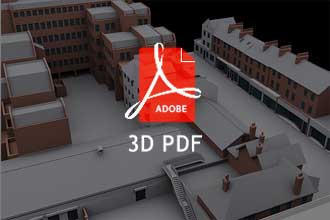3D PDF (*.pdf, *.prc, *.u3d)
Let’s overview the 3 different extensions!
PDF

is a portable document format used to present documents independently from application softwares, hardwares, and operating systems. PDF was developed in the early 1990s to share documents, including text formatting and inline images, among computer users of diverse platforms who may not have access to compatible application software. Adobe Systems made the PDF specification available free of charge in 1993.
PDF 1.6 supports interactive 3D documents embedded in the PDF – 3D drawings can be embedded using U3D or PRC and various other data formats.
Source: wikipedia
U3D
is a compressed file format standard for 3D computer graphics data. This format is natively supported by the PDF format and 3D objects in U3D format can be inserted into PDF documents.
Source: wikipedia
PRC
PRC (Product Representation Compact) is a 3D data structure and file format used in 3D PDF documents. Along side U3D, PRC is now the preferred and most feature-rich method to embed 3D interactive data and models into a PDF file. It includes structure, geometry and product manufacturing information ( PMI ) metadata.
PRC Benefits over U3D
Although both U3D and PRC are available as 3D systems in a PDF, PRC is generally preferable due to:
- More geometric shape definitions, including NURBS
- Much better triangle mesh compression
- Annotations, PMI, Markup
- Scales to Complex Assemblies
Source: pdf3d.com
 is a portable document format used to present documents independently from application softwares, hardwares, and operating systems. PDF was developed in the early 1990s to share documents, including text formatting and inline images, among computer users of diverse platforms who may not have access to compatible application software. Adobe Systems made the PDF specification available free of charge in 1993. PDF 1.6 supports interactive 3D documents embedded in the PDF – 3D drawings can be embedded using U3D or PRC and various other data formats.
Source: wikipedia
is a portable document format used to present documents independently from application softwares, hardwares, and operating systems. PDF was developed in the early 1990s to share documents, including text formatting and inline images, among computer users of diverse platforms who may not have access to compatible application software. Adobe Systems made the PDF specification available free of charge in 1993. PDF 1.6 supports interactive 3D documents embedded in the PDF – 3D drawings can be embedded using U3D or PRC and various other data formats.
Source: wikipedia
